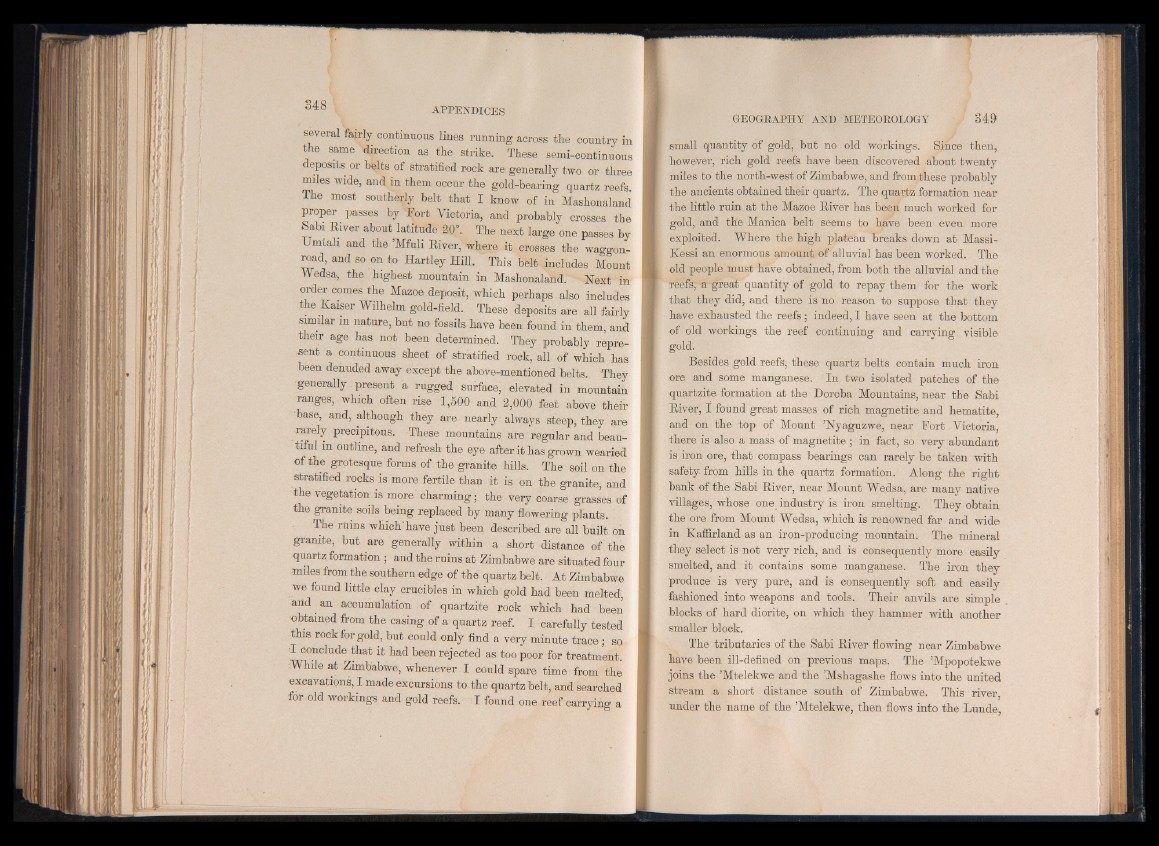
several fairly continuous lines running across the country in
the same direction as the strike. These semi-continuous
deposits or belts of stratified rock are generally two or three
miles wide, and in them occur the gold-bearing quartz reefs.
The most southerly belt that I know of in Mashonaland
proper passes by Fort Victoria, and probably crosses the
Sabi River about latitude 20°. The next large one passes by
Umtali and the ’Mfuli River, where it crosses the waggon-
road, and so on to Hartley Hill. This belt includes Mount
Wedsa, the highest mountain in Mashonaland. Next in
order comes the Mazoe deposit, which perhaps also includes
the Kaiser Wilhelm gold-field. These deposits are all fairly
similar m nature, but no fossils Rave been found in them, and
their age has not been determined. They probably represent
a continuous sheet of stratified rock, all of which has
been denuded away except the above-mentioned belts. They
generally present a rugged surface, elevated in mountain
ranges, which often rise 1,500 and 2,000 feet above their
base, and, although they are. nearly always steep, they are
rarely precipitous. These mountains are regular and beautiful
in outline, and refresh the eye after it has grown wearied
of the grotesque forms of the granite hills. The soil on the
stratified rocks is more fertile than it is on the granite, and
the vegetation is more charming; the very coarse grasses of
the granite soils being replaced by many flowering plants.
The ruins which'have just been described are all built on
granite, but are generally within a short distance of the
quartz formation ; and the ruins at Zimbabwe are situated four
miles from the southern edge of the quartz belt. At Zimbabwe
we found little clay crucibles in which gold had been melted,
and an accumulation of quartzite rock which had ' been
•obtained from the casing of a quartz reef. I carefully tested
this rock for gold, but could only find a very minute trace ; so
•I conclude that it had been rejected as too poor for treatment.
While at Zimbabwe, whenever I could spare time from the
excavations, I made excursions to the quartz belt, and searched
for old workings and gold reefs, I found one reef carrying a
small quantity of gold, but no old workings. Since then,
however, rich gold reefs have been discovered about twenty
miles to the north-west of Zimbabwe, and from these probably
the ancients obtained their quartz. Thé quartz formation near
the little ruin at the Mazoe River has been much worked for
gold, and the Manica belt seems to have been even more
exploited. Where the high plateau breaks down at Massi-
Kessi an enormous amount of alluvial has been worked. The
old people must have obtained, from both the alluvial and the
reefs, a great quantity of gold to repay them for the work
that they did, and there is no reason to suppose that they
have exhausted the reefs ; indeed, I have seen at the bottom
of old workings the reef continuing and carrying visible
gold.
Besides gold reefs, these quartz belts contain much iron
ore and some manganese. In two isolated patches of the
quartzite formation at the Doroba Mountains, near the Sabi
River, I found great masses of rich magnetite and hematite,
and on the top of Mount ’Nyaguzwe, near Fort. Victoria,
there is also a mass of magnetite ; in fact, so very abundant
is iron ore, that compass bearings can rarely be taken with
safety, from hills in the quartz formation. Along the right
bank of the Sabi River, near Mount Wedsa, are many native
villages, whose one industry is iron smelting. They obtain
the ore from Mount Wedsa, which is renowned far and wide
in Kaffirland as an iron-producing mountain. The mineral
they select is not very rich, and is consequently more easily
smelted, and it contains some manganese. The iron they
produce is very pure, and is consequently soft and easily
fashioned into weapons and tools. Their anvils are simple
blocks of hard diorite, on which they hammer with another
smaller block.
The tributaries of the Sabi River flowing near Zimbabwe
have been ill-defined on previous maps. The ’Mpopotekwe
joins the ’Mtelekwe and the ’Mshagashe flows into the united
stream a short distance south of Zimbabwe. This river
under the name of the ’Mtelekwe, then flows into the Lunde,